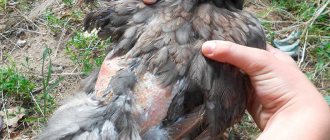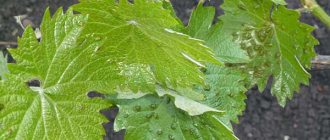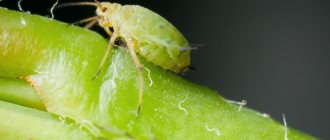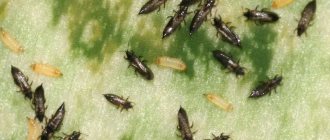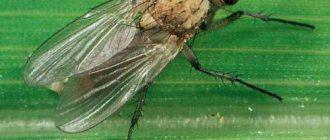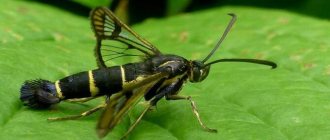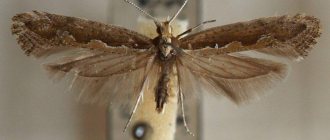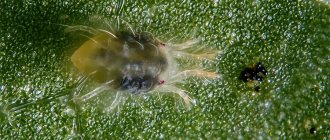Hi all! What do mites look like on laying hens and broilers? We look at the photos and read ways to combat chicken mites and prevent re-infestation of birds by bloodsuckers. Parasitic diseases are not as dangerous as some viral and bacterial diseases.
At the same time, massive parasite infestation in private household plots and farms often leads to the loss of the entire poultry population. And these are additional financial, time and labor costs.
In the best case, chickens’ egg production decreases and meat productivity indicators decrease. Young animals begin to lag behind in growth and development. Add to such dire prospects the fact that blood-sucking parasites are sources of pathogenic microflora.
Today we will look at the biology of chicken mites, the nuances of prevention and ways to combat them. Of course, the most effective way to fight would be a pest control service. Professional treatment of chicken coops and poultry houses against chicken mites means the complete destruction of all parasitic insects and consultations for poultry farmers.
How dangerous are parasites for chickens?
Scabies, blood-sucking, and other types of mites that parasitize chickens bother poultry more than fleas or lice eaters. Dangerous ectoparasites cause severe exhaustion, disrupt the barrier function of the skin, worsen the condition of the feathers, and at the same time are carriers of many deadly infections.
Ticks are widespread in nature and are active in the warm season. They feed on blood and elements of cellular structures. Parasites live on birds' legs, in feather pouches, feather follicles, and in the upper and deep folds of the epidermis.
In domestic chickens, mites cause the following diseases:
- Knemidocoptosis of the body (body scabies). The disease is caused by ticks of the genus Knemidocoptes. They live in the deep folds of the epidermis. They provoke inflammation and destroy dermal cells. A characteristic sign is the appearance of small nodules on the body. This type of mite can infect the legs.
- Epidermoptosis (skin-eaten scabies). Caused by the epidermoptes mite. It parasitizes feather follicles and fluff. It provokes feather loss and acute inflammation in various structures of the dermis.
- Cytolichiosis, cytoditosis, sternostomosis. The disease is caused by a tick from the genus Cystodis. It parasitizes the bronchi and upper respiratory tract of birds.
- Malophagosis. The disease is caused by ticks. They live in the subfeather space, under the wings, and infect the feather spine.
Chicken infected with feather mites
Ixodid mites, which are ubiquitous, do not pose a particular danger to chickens. Parasites feed on blood. In rare cases, females attack a bird, but after drinking blood, they fall off. If you find an ixodid tick on the body of a bird, do not panic. They are not dangerous for poultry.
Prevention
A good preventative against chicken mites is regular disinfection, which is repeated every month, treating the room itself and the cages where the birds live. Machine oils and diesel fuel are often used as disinfectants. Poultry litter must be cleaned or replaced monthly.
Quartz treatment is a preventive measure of disinfection - it reduces the percentage of ectoparasites in the chicken coop.
To prevent the appearance of ticks and parasites, it is necessary to remove the cobwebs where insects settle and subsequently move onto the bird’s body.
Wormwood grass, lemon balm, tomato and potato tops, onion and garlic feathers, and parsley are used as folk remedies. The smell of these plants repels parasites, while:
- bunches of wormwood are hung in the chicken coop and added to the grass bedding;
- A spray is made from garlic, for which 30 grams of crushed garlic are diluted in 1.5 glasses of water; for effectiveness, bay leaf, cloves, lemon balm and lavender are mixed in; they should be used to treat the feather cover of birds and the internal structures of the room;
- plant tops are laid out on the floor.
Signs of chicken infection
You can tell that a bird is infected with mites based on several signs. Parasites can be seen in different places in the poultry house - on the walls, under perches, in cracks in the floor.
If the bird has become inactive, experiences severe itching, egg production has decreased, young animals are not gaining weight well, the condition of the plumage has worsened, or bald spots have appeared on the body, it is most likely that the chickens are infected with mites.
Pay attention to the behavior of your feathered charges. If hens begin to clean their feathers more often, pluck feathers under their wings, in the cloaca area, and constantly take “sand” baths, this may also indicate an infection with feather mites and scabies mites.
Ticks in the chicken coop
Other symptoms of mites in chickens:
- weakness, apathy;
- wounds, scratches, sores on the body;
- dry frequent cough, shortness of breath;
- pallor of mucous membranes, comb, earrings;
- lack of egg production in laying hens;
- weight loss;
- refusal to eat, increased thirst.
Upon closer examination, you can see small red or black spots, small grains, droplets of blood on the feathers, body of birds or on the walls of chicken coops and perches.
You can detect a tick by placing material from a nest, perch, or chicken coop on a white sheet of paper and examining it in bright light. It is best to collect material in the evening, at night.
Acarymorpha mite
Having determined that a bird is infected with ticks, you need to immediately get rid of the blood-sucking parasites, since under favorable conditions they multiply very quickly, and the infestation can become a real problem, which will result in large financial losses. Even if the mite lives on only one chicken, over time, if the bird is not cured and the ectoparasites are not removed, the entire chicken population will be infected.
Symptoms of mallophagosis
The following signs indicate the appearance of feather eaters in chickens:
- the feather shafts are damaged at the base;
- there are bare areas on the body due to the fact that the chicken constantly itches and pulls out fluff;
- the bird is in a state of constant neurosis and seems restless;
- young animals lag behind in development and gain weight poorly;
- a liquid is released from the eyes of birds, which, when dried, forms a crust;
- the affected areas gradually lose feathers and become covered with small abrasions.
As a rule, breeders identify a parasitic infection by a “bald back”, but in some cases this sign indicates baldness of the bird due to poor housing and feeding. The fact is that a lack of vitamin D, dry air and cramped conditions or stale air and high humidity lead to the bird shedding its feathers. This also occurs during normal shedding, although not to the same extent as during the disease.
Thus, to accurately determine mallophagosis, one should take into account the presence of not only a “bald back”, but also other symptoms characteristic of this disease.
We recommend that breeders read the article about what other dangerous chicken diseases exist.
Red chicken mites
The red chicken mite, which got its name because of the color of its small body, belongs to the class of blood-sucking parasites. It is a carrier of various viruses, bacteria, and spreads the causative agent of cholera, typhoid, borreliosis, spirochitosis.
The body length of parasites does not exceed 0.6–0.7 mm. The color of the body is dark brown, brownish-red. After the blood tick drinks blood, the body turns purple. The female is capable of laying 15–20 eggs per day. The maximum period of activity for red chicken mites is from May to mid-October. Parasites have a complex life cycle, which includes several larval stages and depends on environmental conditions. Its duration is 6–13 days.
Red chicken mite
The blood-sucking parasite prefers a warm, humid microclimate. Lives in damp, damp, poorly ventilated areas. The maximum accumulation of chicken mites can be seen in the litter. At the same time, detecting parasites is not so difficult. Some chicken mites are constantly on the surface of the body of an infested bird, others live in chicken coops, poultry houses, hiding in the litter, under perches, in cracks on walls, floors, and at nightfall they leave their shelter in search of a new victim.
Advice! If the chickens are reluctant to enter the chicken coop, set up new nesting places, and experience severe itching, these are clear signs that the bird is infected with red mites.
The red chicken mite feeds on blood, biting and damaging the skin. The bird experiences discomfort, itching, and shows anxiety. The condition of the feathers greatly deteriorates, the immune system weakens, and anemia develops, which can cause the death of infested birds.
Dangerous pests enter farms with newly arrived chickens. Parasites can spread through household items and equipment. Most often, red ticks live in rooms and farmsteads with unsatisfactory sanitary conditions.
Infection is facilitated by high humidity in poultry houses, the absence of sand baths for chickens, and a high density of birds in a limited space. It is worth noting that red chicken mites are dangerous to humans. They cause severe itching and allergies.
When day-old chicks are placed in poultry houses with mites, a high mortality rate is observed. The chicks die from exhaustion and anemia within 5–7 days.
Severe infestation of chicken with chicken mites
Chicken mites that infect nails and bird feathers
In addition to the red chicken mite, feather mites and chicken acariform mites are a danger to domestic chickens, especially small chickens and young birds.
The feather mite in chickens lives on the feather shaft, in the hole, and feeds on circulating blood, which over time leads to the gradual destruction of the feather and deterioration of the plumage. If the infection is severe, chickens may be left with no feathers at all. Unfortunately, at the moment, no effective treatment for feather mites in chickens has been developed.
Feather mites infect the feathers of birds. Feathers become brittle
Acariform mites in chickens provoke knemidocoptosis (leg scabies), to which roosters are more susceptible than hens. The disease is also known as calcareous foot. It develops slowly, so manifestations may not be noticed immediately.
A characteristic sign by which it can be determined that a bird is infected with this type of parasite is the thickening of the stratum corneum of the skin on the legs. The phalanges of the fingers are completely covered with a bluish coating. Severe infection can lead to deformation of the limbs, so sick chickens should be treated immediately after the first symptoms appear.
Important! The parasite lives under the horny scales on the legs of domestic and wild birds. All stages of its development occur on the host. In the external environment, under favorable conditions, there is no more than 10 days. In breeds of chickens that have feathering on their legs, leg scabies is rarely diagnosed.
Infection with leg scabies
If a bird is infected with leg scabies, the sick chicken has difficulty moving and becomes inactive. Dense gray growths are noticeable on the paws. The skin of the legs becomes lumpy. Pathological exudate accumulates under the scales. Over time, if treatment is not started, the scabies mite causes deformation of the limbs.
Treatment
Birch tar is used to treat chicken acariform mites on the legs of poultry. It is heated to a temperature of 40 degrees, poured into a deep bath and the chicken is placed in the solution up to the hock joint. You can simply treat the parasite-affected surface of the leg with tar, using a soft brush, at intervals of 6–7 days.
Birch tar kills mites on chicken legs
Advice! If the mite lives on the legs of chickens, use a solution of Trichlorometaphos or a mixture of birch tar and kerosene in a 1:1 ratio.
If chickens are infected with scabies mites that live on their legs, the parasites can be removed using acaricidal-insecticidal agents of complex action in drops, solutions, and aerosols. They are simply rubbed into the affected skin several times at intervals of 2-3 days.
Effective Methods for Cleaning a Chicken Coop
The main control method that will allow the removal of ticks from poultry is complex disinfection, decontamination of the poultry house, cages, and premises in which the poultry is kept. Treat walls, floors, perches, ceilings, and equipment with insecticidal-acaricidal solutions and special chemicals. Wash feeders and drinking bowls thoroughly. Replace the bedding.
Floors, walls, and perches in chicken coops can be treated with boiling water or a blowtorch. To prevent ticks in the poultry house, you can hang wormwood, mint, tomato, potato tops, parsley, onions, and garlic in the corners. The aromas of these plants repel not only chicken mites, but also other ectoparasites.
For decarification you can use:
- cyodrine 0.5%;
- dicresol 0.25%;
- karbofos;
- chlorophos 1–2%;
- trichlorometaphos 0.5–1%;
- DDVF 0.25–0.5%;
- neocidol 0.25–0.5%.
Chlorophos is used to disinfect poultry houses
Important! If a bird is affected by red or Persian mites, the poultry houses are treated two to three times with an interval of 3–6 days.
Examine the chickens carefully. If there are wounds or scratches on the body, treat the affected areas with antiseptic solutions. The affected areas can be lubricated with vegetable oil, wound healing ointments, and liniments.
There are many effective acaricidal agents on the market to combat chicken mites. To get rid of parasites, veterinarians recommend using for chickens:
- Sevin (powder).
- Ecoflix (oily liquid).
- Extrasol M (aerosol).
- Pyrethrum.
- Promectin.
- Ectomin (emulsion).
- Spray with pyremethrin EC (new generation insecticide).
Acaricide against ticks for birds
In case of severe infestation, ticks will have to be removed in several approaches. Treatments are carried out at intervals of 5–10 days, depending on the product used.
Before use, carefully read the instructions for the drug. When choosing an insecticide-acaricide, be sure to consult a veterinarian. Some drugs are strictly forbidden to be used for treatments, since their active substances accumulate in eggs and meat.
In the fight against chicken mites, you can use folk remedies. Add wood ash to sand baths. By cleaning the feathers in this mixture, the bird removes parasites from the body. Sand baths with ash are also a good method of preventing chickens from becoming infected with mites. Do not forget to periodically change the composition of the “dusty” baths.
Reasons for appearance
You can't completely protect chickens from ticks, but you can prevent their spread. In a poultry house, parasites appear with new livestock or through contact with rodents or wild birds. Poor cleaning of the chicken coop also leads to the spread of arthropods. Feces, fluff and other traces of bird activity provide a fertile breeding ground for ticks. Poor ventilation and high humidity levels also contribute to this.
Chickens rarely bathe directly in water. Therefore, they need sand baths to clean their feathers. Floundering in it, they shake off small parasites from themselves. Large crowding in cells leads to the rapid spread of ticks. Arthropods can be brought into a bird's home through human clothing, shoes, and equipment.
